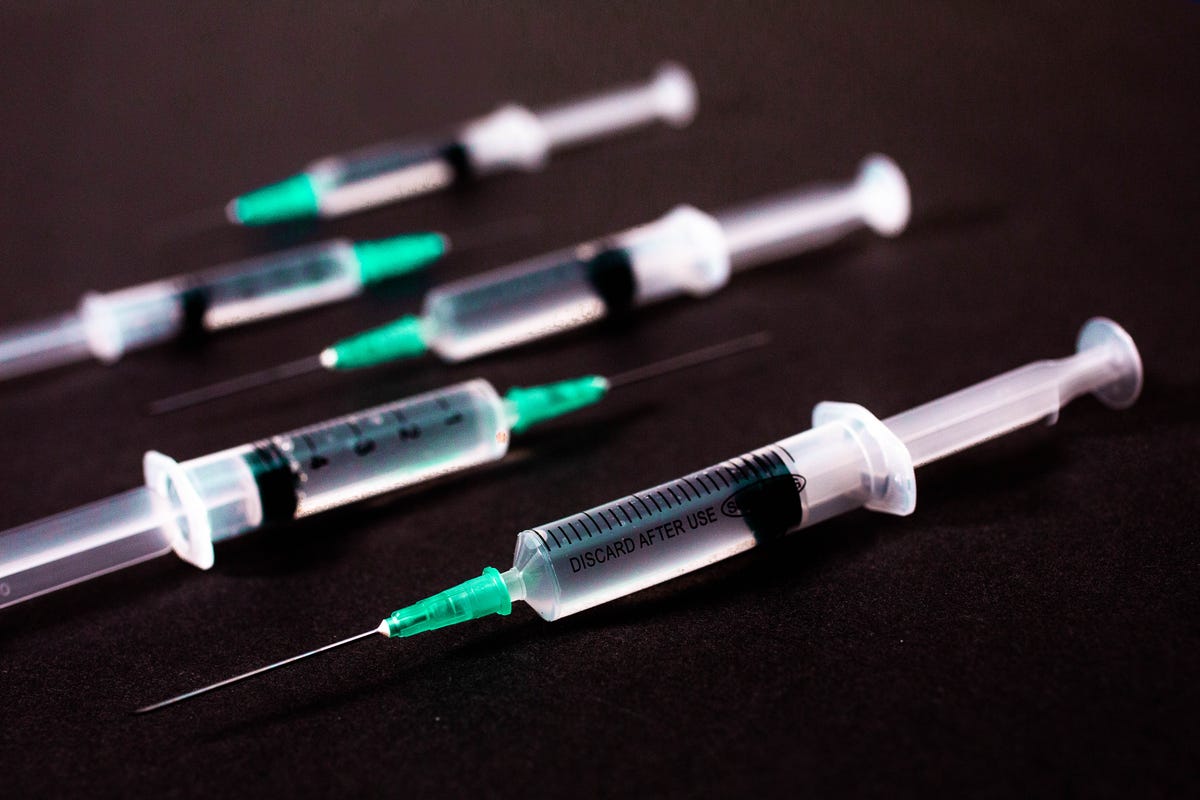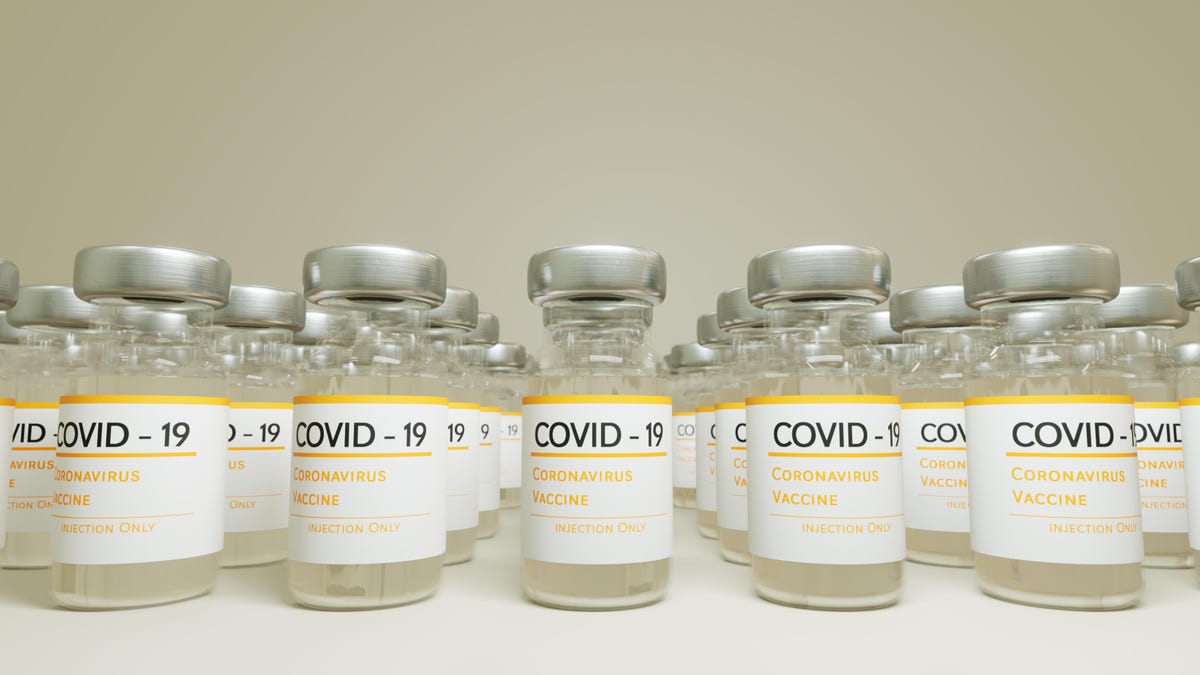What’s happening
New boosters from Pfizer and Moderna that target the newest strains of the omicron variant have arrived.
Why it matters
The older vaccine formulas are still effective at preventing severe disease, but the mutating virus has whittled some of that protection away. The new formulas target BA.5, which is responsible for most current COVID-19 cases.
What’s next
Shots are available throughout the country. People age 12 and older are eligible for one.
Updated vaccines that target the newest versions of COVID-19, BA.4 and BA.5, are now available — probably at a site within five miles of you. These new vaccines, which are just one booster of Pfizer’s or Moderna’s updated formulas, were created to be a defense against COVID-19 this fall and winter when many people will be spending time indoors, cozying up and sharing air with others.
While the original vaccines still offer protection against severe disease, infection protection from the vaccines has waned significantly from when they first rolled out as the virus continues to mutate. And while the rate of people dying or being hospitalized from COVID-19 is markedly better than earlier points in the pandemic, an average of more than 400 deaths per day are still being reported in the US this month.
But questions on the new vaccines remain: Who can get one? When should they get it, and can they get the flu shot at the same time?
Here’s what we know.
Read more: Best Home COVID Tests


Were the new COVID vaccines tested?
The US Food and Drug Administration authorized Pfizer-BioNTech’s and Moderna’s bivalent (two-component) vaccine boosters. Both formulas include the BA.4/BA.5 spike protein from omicron’s subvariants combined with an older strain — a combo design that experts believe will offer better protection against both infection and severe illness. Pfizer’s booster is for people age 12 and older, and Moderna’s is for adults 18 and up.
When they were authorized by the FDA, the agency made its decision on clinical trials on a slightly different bivalent booster that targets the BA.1 version of omicron instead of BA.4/BA/5, in addition to mice studies on the BA.4/BA.5 formula. While this has been unprecedented in the COVID-19 vaccine campaign so far, health officials say it’s not too far off from the way we approach influenza vaccines. Every year, the flu vaccine is tweaked with a strain they believe to be the best target. The new COVID-19 boosters also do not introduce any new vaccine ingredients.
“Bivalent and multivalent vaccines are very common and modifying a vaccine to include different virus strains often does not require a change in other ingredients,” FDA Commissioner Rober M. Califf said in a tweet last month. “FDA has extensive experience with reviewing strain changes in vaccines, as is done with the annual flu vaccine.”
When should I get the new booster?
The updated Moderna and Pfizer-BioNTech boosters are authorized by the FDA for people who’ve gone at least two months since their last vaccine dose, whether it be a booster shot or a primary series. It doesn’t matter which vaccine you originally received, and it shouldn’t matter which brand you choose now. Moderna’s new booster, like its previous vaccine, is a slightly larger dose (50 micrograms) than Pfizer’s (30 micrograms).
At a panel meeting of the US Centers for Disease Control and Prevention’s scientific advisers, a committee that meets before the CDC recommends a vaccine — a few members expressed concern that some people would be better off waiting longer than two months between their last shot and this new booster, especially people who have recently had COVID-19 and still have relatively high immunity. (In its general vaccine guidance, the CDC says that people can wait three months before getting the shot if they’re getting over COVID-19.)
And while myocarditis is rare overall, younger men and teenage boys appear to be at higher risk post-vaccination, and waiting longer between vaccine doses appears to reduce this risk.
From an immune response perspective, some infectious disease doctors have suggested waiting four to six months between your last COVID-19 infection or vaccine to get the most bang out of the new booster. Dr. Anthony Fauci told PBS that if you tested positive for COVID-19 recently, “you should wait about three months, at least three months from the time that you had a prior infection” before getting the new booster. Fauci added that because he had COVID-19 in the middle and end of June, he’s waiting until the end of September to get boosted.
Dr. Monica Gandhi, an infectious disease expert and professor of medicine at the University of California, San Francisco, told the San Francisco Chronicle that people age 65 and older should be the focus of the booster campaign this fall, since older adults have been at much higher risk of severe COVID-19 disease than younger folks. (More than 81% of COVID-19 deaths occur in people over age 65, according to the CDC.) But some younger adults and teens are also at higher risk of severe disease because of an underlying health condition, and may benefit from getting additional immunity sooner rather than later.
But people with perceived lower risk, or those at higher risk wanting to wait it out to get closer to a predicted surge of cases, could also be playing a risky game. Dr. Aniruddha Hazra, an infectious disease specialist at the University of Chicago, told NPR that it takes a “few weeks for our immune systems to be primed” after we get vaccinated.
Bottom line: The “best time” for getting the new COVID-19 booster is a bit of a moving target, and depends on your individual health factors and risk, as well as the last time you had a confirmed infection or booster. For the best recommendation for you, call your doctor.
Where can I get a new vaccine?
You should be able to use the vaccine finder site vaccines.gov to find an updated vaccine near you. When you’re choosing your updated booster from either Pfizer-BioNTech or Moderna, make sure to select the shot that says “Newly Authorized Bivalent” in bold text. Primary series vaccines, or the first two doses, are still available for people who haven’t received any vaccine yet.
Smaller doses of the original vaccines are also still available for kids as young as six months.
Can I get a flu vaccine at the same time as my booster?
Yes, according to the CDC. There’s no recommended waiting period between the seasonal flu shot and the COVID-19 vaccines.
The flu vaccines for the 2022-2023 season have been updated, and the CDC still considers September or October good months for most people to get their flu shot.
What are the BA.4 and BA.5 subvariants?
Both BA.4 and BA.5 are considered part of the “original” omicron variant (BA.1) family. They’re newer versions of the virus that causes COVID-19. BA.5 quickly overtook the conversation and is now the dominant variant in the US.
While we’re still living out the true effects of a BA.5 summer surge in the US, the new subvariant is thought to whittle away much of the infection protection people got from prior sickness, even with other omicron variants.
Omicron caused such a huge number of cases last winter because it was the most contagious variant to date, evading some infection protection from prior illness and effectiveness of the vaccines. The fact that newer versions of omicron are proving to be even more contagious isn’t a big surprise, as this is the path COVID-19 has taken over the last two and half years.
Read more about everything we know about BA.5.


What about Novavax and J&J?
Novavax, which just received the CDC’s recommendation for its primary two-dose vaccine, said earlier this summer that it’s speeding up work on a formula specifically targeting the new versions of omicron, but it isn’t on the table yet for this fall and winter vaccine campaign.
Johnson & Johnson’s COVID-19 vaccine, though still available in the US, has been recommended only for people who can’t take, or don’t want to take, another COVID-19 vaccine, because of the risk of a very rare but dangerous side effect. J&J didn’t respond to an earlier request for comment on the company’s plans for the fall in the US.
The information contained in this article is for educational and informational purposes only and is not intended as health or medical advice. Always consult a physician or other qualified health provider regarding any questions you may have about a medical condition or health objectives.


